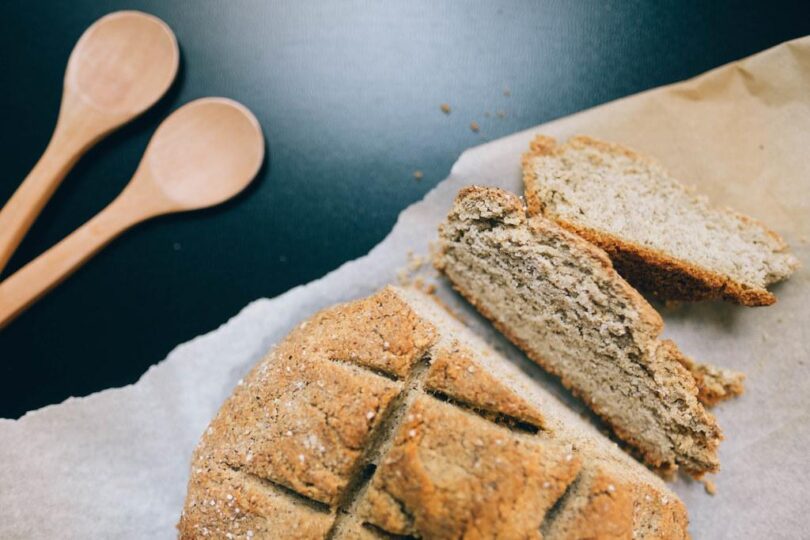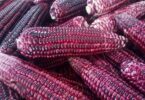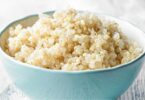Eating a gluten-free diet doesn’t mean sacrificing taste or variety in your meals. With a wide range of delicious and nutritious gluten-free grains available, it’s possible to make healthy and flavorful dishes to suit any palate. Discover the goodness of gluten-free grains with this Guide to Good Eating!
1. Introducing Gluten-Free Grains
- Have you been diagnosed with a gluten intolerance, wondering how you can enjoy food without it? Or perhaps you’re looking to diversify your diet? You’re in luck; there’s a huge range of gluten-free grains to offer delicious alternatives while keeping you healthy and well.
- With over 10 types of grains to choose from, it may be daunting at first but there’s sure to be something to suit your tastes. Whether you prefer boiled, fried, baked, or even in soup, there’s something you can enjoy — without the gluten. Here’s a quick overview of the most popular gluten-free grains.
Teff
Small but mighty — teff grain packs a nutritive punch! Teff is one of the smallest grains on earth, but its miniature size is more than made up for in its fiber and iron content. Rich in essential minerals and protein, it’s great for those avoiding gluten. Opt for teff flour and you can make easy, flavorful flatbread, or medium-coarse and you’ll find teff’s nutty flavor pairs perfectly with hearty root vegetables.
Buckwheat
Coming in all shapes and sizes, buckwheat is a great option for those on the path to being gluten-free. Packed full of fiber, B vitamins, and essential amino acids, it’s a tasty and versatile grain. For a very traditional flavor, try roasting and grilling it as a savory side. Enjoy it in pancakes, muffins, wraps, salads, and so much more. Its distinct nutty flavor pairs well with bold flavors, and you can enjoy it hot or cold.
Rice
Whether you’re a fan of white or brown, short- or long-grained rice — it’s definitely a winner among gluten-free grains. Rich in fiber, protein, and complex carbohydrates, most of us are sure to find a favorite type. Try it in everything from stir-fries and salads, to risotto and curries. For breakfast it pairs well with nuts, seeds, and dried fruit. It’s also fantastic as a comforting porridge.
Quinoa
A high protein, gluten-free grain, quinoa is an excellent substitute for wheat and other grains. It’s a great source of dietary fiber, making it super satisfying and filling! A great way to enjoy it is to stir-fry it up with your favorite vegetables, fresh herbs, and spices for a flavorful meal. It also goes great in soups and salads, salads, and even pancakes!
Amaranth
High in protein and other essential nutrients, amaranth is packed full of goodness. This ancient grain has been used for centuries in Nepal, India, and other parts of the world. Its slightly sweet and nutty flavor pairs well with sweet and savory dishes alike. Tarhana soup is a classic example, a flavorful and warming soup that can be enjoyed all year round. Other great dishes include crunchy breakfast bars, fluffy sweet muffins, and scrumptious smoothie bowls.
Millet
One of the most versatile gluten-free grains millet can be made into flour for pancakes, porridge, and breads. It’s also perfect for adding crunch to salads or dishes like risotto. In India, it’s used in the traditional meal, upma. Swapping wheat-based ingredients for traditional favorites is a great way to maintain taste without the gluten.
So there you have it — gluten-free grains that are delicious, nutritious, and packed full of fiber. With this guide, you can start experimenting with different dishes and grains to find the perfect flavor combinations for you. Bon appetit!
2. Types of Gluten-Free Grains
When it comes to gluten-free eating, grains can be tricky. From barley to spelt, wheat is a staple in many dishes, so it can be difficult to know which grains are truly safe to consume. Fortunately, there’s a whole world of grains that are widely available, nutritious, and most importantly, gluten-free. Here’s a breakdown of the types of grains that you can enjoy as part of a balanced, gluten-free diet:
- Rice – From white rice to wild rice, there’s a variety of delicious rice grains that can be incorporated into your meals. Rice is a key ingredient in many dishes, and a great gluten-free option.
- Quinoa – Quinoa is a versatile and tasty grain with a mild, nutty flavor. This type of grain can be used in breakfast, lunch, and dinner dishes, and is a great source of fiber, iron, and protein.
- Amaranth – This nutrient-dense grain is gluten-free and also high in fiber. Amaranth is often used in baked goods such as muffins and breads.
- Buckwheat – Although it may be confusing, buckwheat is actually wheat free despite its name. It can be used to make flour, and is an excellent source of fiber.
- Corn – Corn can be used in many different dishes, but it’s also a great source of gluten-free flour. Corn flour is commonly used in gluten-free baking, and is a great gluten-free substitute for wheat flour.
It can be difficult to find gluten-free grains in traditional grocery stores, so pay special attention when checking labels to ensure that the product is truly gluten-free. These are just some of the many gluten-free grains that you can safely enjoy as part of a healthy and balanced diet.
3. How to Incorporate Gluten-Free Grains Into Your Meal Plan
For those who are gluten-intolerant or have celiac disease, following a gluten-free lifestyle can often feel like a challenge. But with all the gluten-free grains available, it’s easier than ever to enjoy a variety of foods without worrying about wheat-based products. Here’s a guide on :
- Amaranth : Amaranth is an ancient grain that has been consumed for thousands of years. It has a slightly nutty taste and is a great substitute for wheat-based pastas or couscous. It also contains high levels of protein and fiber making it a great addition to any meal plan.
- Buckwheat : Buckwheat is a great substitute for wheat-based flour, and can be used to make breads, pancakes, muffins and pasta. It is also high in fiber and magnesium, making it a nutritious choice.
- Millet : This tiny grain has a subtle sweetness that makes it a great addition to salads, soups and veggie burgers. It’s also high in fiber, which can help keep you full longer.
- Quinoa : Quinoa may be small in size but it’s packed with nutrients such as iron, magnesium and zinc. It’s fairly neutral in taste and can be used as a substitute for rice or as an addition to salads and soups.
- Teff : This ancient grain is rich in fiber, calcium and magnesium. It has a mild, nutty flavor that makes it a great substitute for wheat-based pastas and breads.
So, as you can see, there are many delicious and nutritious gluten-free grains that you can incorporate into your meal plan. With a little bit of creativity, you can create delicious and nutritious meals for you and your family to enjoy.
4. Benefits of Eating Gluten-Free Grains
Whilst many people are now aware of some of the well-known grains such as wheat, rice and barley, not all of us are familiar with the numerous gluten-free grains that can provide us with a range of health benefits. Below is a guide to some of the healthiest gluten-free grains:
- Amaranth – this ancient grain, which is high in dietary fibre and protein, is naturally gluten-free. Amaranth is an excellent source of manganese, calcium and iron.
- Buckwheat – despite its name, buckwheat is not actually a wheat grain, meaning it is gluten-free. Buckwheat is high in protein and dietary fibre, and is a great source of magnesium and phosphorus.
- Quinoa – a nutrient-packed grain, quinoa is a great source of complex carbohydrates, protein and dietary fibre. Quinoa is also high in magnesium, iron and B vitamins.
- Chia Seeds – considered to be a superfood, chia seeds contain omega-3 fatty acids, and are a great source of dietary fibre. They can absorb 10-12 times their weight in water, making them a great way to stay hydrated.
Not only are these grains packed with all of the essential nutrients our body needs, but they can do wonders for our digestive system too. Eating gluten-free grains can boost digestive health, reduce bloating and help to get the most out of the nutrition in the food we consume.
In addition to improved digestive health, eating gluten-free grains can also have a positive effect on our weight loss goals as they provide the body with energy without the unnatural side-effects that often come with processed foods. As these grains also contain few calories and are low in fat, they can help to reduce our overall calorie intake.
Therefore, by incorporating gluten-free grains into our diets, we can not only benefit from their nutrious content, but also improve our digestive system and reach our weight loss goals.
5. Making Gluten-Free Grains Delicious and Nutritious
When it comes to gluten-free eating, grains can be a great way to get the nutrients your body needs. With the right combination of flavors and ingredients, you can turn any ordinary gluten-free grain into a power-packed meal. Here are five tips on how to make gluten-free grains more delicious and nutritious.
- Choose Whole Grains: As with all gluten-free grains, it is best to choose whole grains when possible. Whole grains, such as quinoa, are packed with protein, vitamins, minerals, and antioxidants. They are also higher in fiber and have a lower glycemic index than refined grains, making them a healthier choice.
- Experiment with Flavors: Take advantage of the versatility of gluten-free grains by experimenting with new flavors and spices. From curry powder to garlic, herbs, and even citrus, adding a little extra flavor can make any gluten-free grain stand out.
- Include Protein-Rich Ingredients: Introduce some protein-rich ingredients into your gluten-free grain preparations. Consider adding nuts, seeds, beans, or legumes to round out the meal.
- Mix and Match: Fusion cuisine is a great way to make gluten-free grains even more delicious. Experiment with recipes from different cuisines and cultures, such as Indian curries, Mexican tacos, and Mediterranean zucchini patties.
- Make it a Balanced Meal: Add vegetables, fruits, and other healthy sides to make your meal complete. A green salad or roasted vegetables can add flavor and nutrition. You can also top your grain dish with a flavorful condiment or dressing, such as pesto, hummus, or salsa.
Gluten-free grains are a delicious and nutritious way to get the vitamins and minerals your body needs. With a little creativity and experimentation, you can turn any ordinary grain into a flavorful and nutritious meal.
6. Tips for Shopping and Storing Gluten-Free Grains
Shopping for Gluten-Free Grains
There are several types of gluten-free grains available in the market these days. You should always read labels and check for gluten before purchasing any grains. Here are some tips for shopping for gluten-free grains:
- Look for grains that are labeled as 100% gluten-free. This is one of the most reliable indicators that a grain is truly gluten-free.
- Try organic gluten-free grains. They are usually more expensive, but they have a higher level of purity.
- Be aware of cross-contamination. Gluten-free grains can become cross-contaminated if they come into contact with gluten-containing ingredients.
- Do your research. As the prevalence of gluten-free diets increases, there are more and more varieties of gluten-free grains in stores.
- Purchase from companies that are dedicated to providing only gluten-free products.
Storing Gluten-Free Grains
Once you have purchased your gluten-free grains, it’s important to store them properly to ensure their freshness and flavor. Here are some tips for storing gluten-free grains:
- Make sure you store your gluten-free grains in an airtight container. This will keep out moisture and pests.
- Keep your grains away from direct sunlight. This will help to preserve their flavor and texture.
- Be sure to store your grains in a cool, dry place. A pantry or cupboard is ideal.
- If you don’t have a pantry or cupboard, you can store the grains in the refrigerator or freezer.
- If you store the grains in the refrigerator or freezer, make sure you take them out a few days before use and allow them to adjust to room temperature before cooking.
7. Conclusion: Making Healthy Eating Easier with Gluten-Free Grains
A gluten-free diet isn’t all deprivation, as there are plenty of good options when it comes to grains.
- Millet: A light and fluffy grain that is versatile and can be used in salads, sandwiches, and soups.
- Amaranth: A nutrient-rich grain that, when cooked, can be used as an alternative to couscous or grits.
- Buckwheat: The hulled kernels of this grain, often called ‘kasha’, are a great substitute for rice in dishes, or can be used as a porridge-like breakfast dish.
- Chia Seeds: These tiny seeds are rich in Omega 3 fatty acids, and can be used in baking or sprinkled atop yogurt or oatmeal.
- Quinoa: A popular superfood, quinoa is a complete protein that can be used in baking, tossed in salads, or cooked as a side dish.
Making the switch to gluten-free grains doesn’t have to be a daunting endeavor. If you’re looking to make your diet healthier, these grains are a great place to start. All are full of nutrients, and can make tasty, delicious and healthful meals. By supplementing traditional grains with them, you can make your diet healthier in no time.
Eating a variety of gluten-free grains is one of the simplest ways to improve your health and upgrade your diet. From amaranth to quinoa and more, there is something for everyone to explore and enjoy. So go ahead and invite gluten-free grains into your kitchen. You—and your taste buds—will be glad you did!








